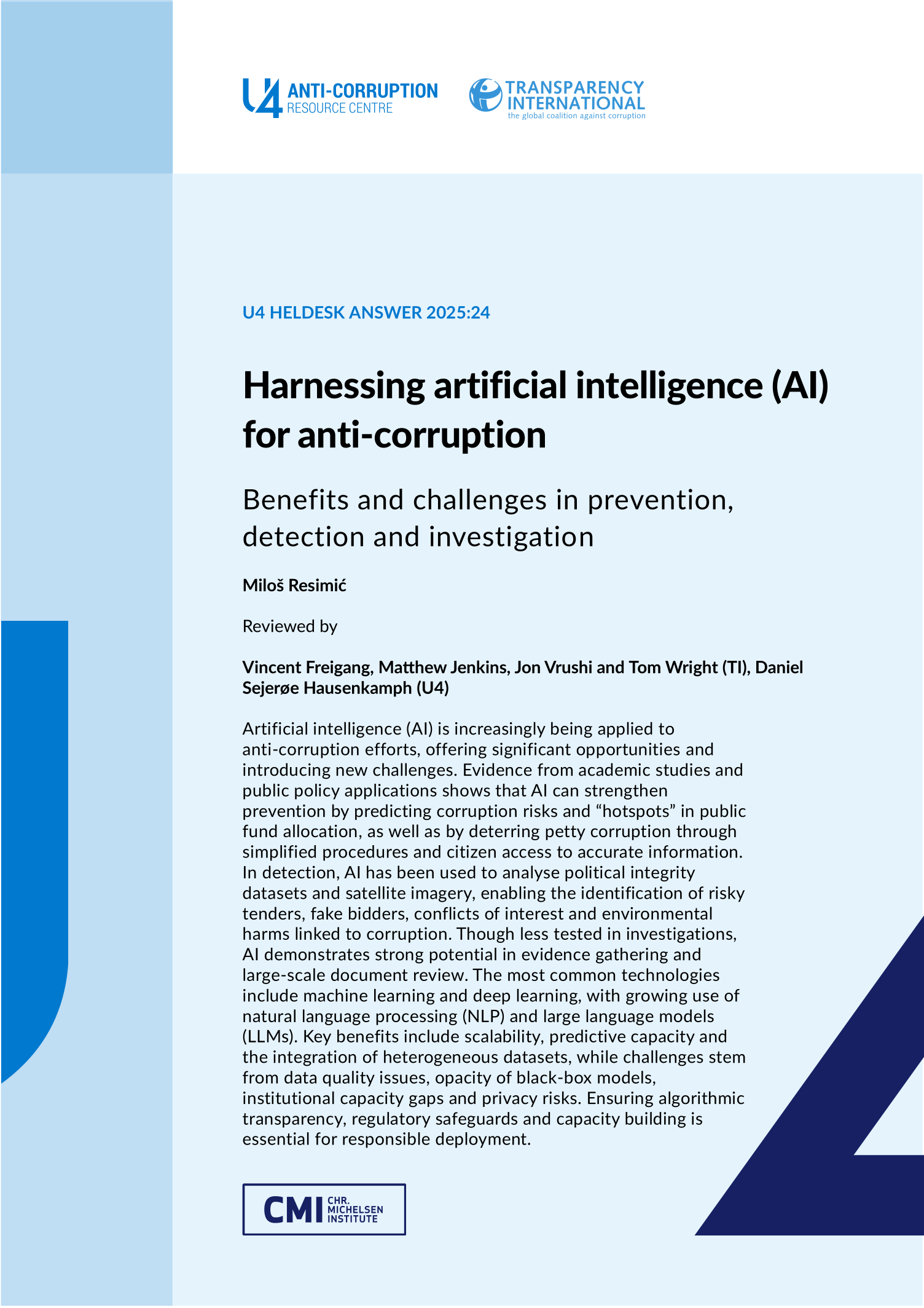Main points
- Key features of AI technologies include autonomous learning and task execution, leveraging advanced computing power and the ability to exploit novel data sources like satellite imagery. As such, applying these technologies to anti-corruption efforts can bring benefits such as the reduction of human error, the simplification of repetitive tasks and improved targeting and efficiency in gathering and analysing large datasets.
- Embedding AI – especially LLMs – into existing anti-corruption workflows to automate repetitive data tasks (e.g., converting PDFs to spreadsheets or tabular formats, classifying large datasets, extracting names/dates/entities) delivers immediate value at scale.
- These “mundane” uses of AI in anti corruption efforts can free up scarce staff time and support activities to prevent (cleaner, richer indicators), detect (faster triage of red flags) and investigate (bulk evidence ingestion and entity extraction) corruption while maintaining a degree of human oversight and control.
- As such, there is a broad scholarly consensus that AI should complement existing anti-corruption workflows rather than replace them. Nonetheless, in addition to the “mundane” uses of AI, there are a growing number of cases of AI tools being developed as a dedicated products to deliver specific outputs in the domain of preventing, detecting and even investigating corruption.
- The potential of AI in corruption prevention has mainly been tested in two areas: (i) predicting corruption risks and “hotspots” in the allocation and disbursement of public funds and (ii) deterring lower-level corruption in public service delivery by simplifying procedures and improving access to accurate information for citizens.
- Key benefits of AI in corruption prevention include scalability compared to traditional audits, meaning that state authorities can allocate their finite oversight resources in a more targeted and efficient manner, which can strengthen safeguards and heighten deterrence. Predictive methods can also help authorities intervene before damage occurs (e.g. before a procurement contract is awarded). These tools can integrate heterogenous datasets and thereby help generate more robust corruption risk profiles.
- AI has also been applied in corruption detection, primarily to strengthen accountability and transparency through political integrity datasets and to use satellite imagery to detect corruption risks linked to environmental harm.
- Key benefits of AI in corruption detection include the ability of AI anti-corruption tools (AI ACTs) to detect high-risk tenders, fake bidders or conflicts of interest among public officials.
- While the potential of AI in corruption investigations has been tested far less, a handful of real-world public policy applications highlight potentially promising uses in evidence gathering and large-scale document review.
- Across prevention, detection and investigation, academic studies and public policy applications most commonly employ machine learning and deep learning techniques, though natural language processing (NLP) and generative AI –particularly LLMs – have also been applied.
- There are potentially sizeable challenges and drawbacks to the application of AI technologies to anti-corruption efforts. Across the areas of prevention, detection and investigation, key challenges are similar: data quality issues, algorithmic opacity, regulatory lag, lack of institutional capacity, inclusivity gaps, and concerns around privacy and fundamental rights.
- More fundamentally, data limitations and biases can affect the reliability and accuracy of AI ACTs. In one instance from the UK, apparent shortcomings of an AI tool used by the Serious Fraud Office to support its investigations has resulted in past convictions being questioned on procedural grounds, underscoring the importance of rigorously testing the accuracy of AI ACTs before deployment.
- Perhaps most importantly, any shortcomings in training data can compound skewed historical patterns. If corruption is already under-detected in transaction data and AI models are trained only on the limited cases that are identified, the models will become good at detecting those identified positive cases. However, this also reinforces the blind spots, making it harder for the system to detect the many cases that went unnoticed in the first place.
- Moreover, while AI can reduce traditional opportunities for corruption by limiting human discretion, this can also create new risks. If an AI system is flawed or manipulated, it could systematically misclassify cases or misallocate resources at scale before errors are detected. Transparency International (2025) has proposed the concept of “corrupt uses of AI” to cover instances in which AI systems are abused by entrusted powerholders for private gain. This heightens the need for robust oversight, continuous monitoring and transparent algorithmic audit trails to ensure accountability.
- To ensure responsible deployment of AI in anti-corruption efforts, beyond promoting algorithmic transparency and accountability, it is essential to close institutional and regulatory gaps and invest in sustained capacity building initiatives.


